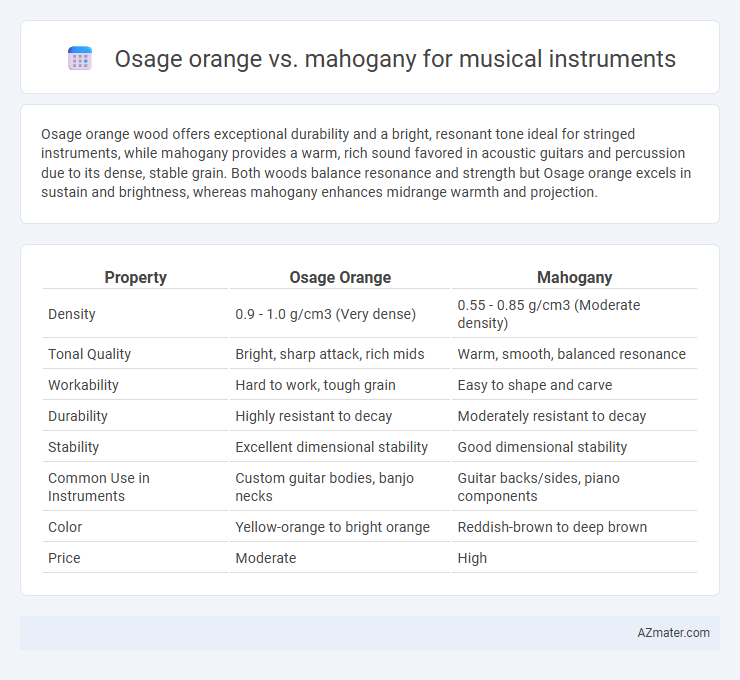Osage orange wood offers exceptional durability and a bright, resonant tone ideal for stringed instruments, while mahogany provides a warm, rich sound favored in acoustic guitars and percussion due to its dense, stable grain. Both woods balance resonance and strength but Osage orange excels in sustain and brightness, whereas mahogany enhances midrange warmth and projection.
Table of Comparison
| Property | Osage Orange | Mahogany |
|---|---|---|
| Density | 0.9 - 1.0 g/cm3 (Very dense) | 0.55 - 0.85 g/cm3 (Moderate density) |
| Tonal Quality | Bright, sharp attack, rich mids | Warm, smooth, balanced resonance |
| Workability | Hard to work, tough grain | Easy to shape and carve |
| Durability | Highly resistant to decay | Moderately resistant to decay |
| Stability | Excellent dimensional stability | Good dimensional stability |
| Common Use in Instruments | Custom guitar bodies, banjo necks | Guitar backs/sides, piano components |
| Color | Yellow-orange to bright orange | Reddish-brown to deep brown |
| Price | Moderate | High |
Overview: Osage Orange and Mahogany in Musical Instrument Crafting
Osage Orange is prized in musical instrument crafting for its dense, strong grain and natural resistance to wear, making it ideal for durable fretboards and bridges. Mahogany is renowned for its warm tonal qualities and stability, commonly used in guitar bodies and necks to enhance sound resonance and sustain. Both woods contribute distinct acoustic properties, with Osage Orange emphasizing durability and bright tones, while Mahogany offers rich warmth and balanced harmonics.
Wood Origin and Botanical Characteristics
Osage orange (Maclura pomifera), native to the south-central United States, is a dense hardwood with a bright yellow to orange heartwood, known for its durability and natural resistance to decay, commonly used in musical instruments requiring stability and bright tonal qualities. Mahogany, primarily from the genus Swietenia, originates in Central and South America, prized for its rich reddish-brown color, fine grain, and excellent resonance, making it a favored material for guitars, violins, and other stringed instruments. Both woods offer distinct tonal characteristics influenced by their botanical properties: Osage orange's heavy, tight grain enhances brightness and sustain, while mahogany's open, straight grain provides warmth and depth in sound.
Acoustic Properties: Tone and Resonance Comparison
Osage orange wood offers a bright, clear tone with excellent projection and strong midrange frequencies, making it ideal for acoustic instruments that benefit from sustained resonance and vibrant sound. Mahogany provides a warmer, richer tone with smooth low-mid frequencies and balanced resonance, favored for its ability to produce well-rounded, mellow sounds in guitars and other stringed instruments. Comparing the two, Osage orange excels in brightness and clarity, while mahogany delivers warmth and depth, influencing the instrument's overall tonal character and projection.
Strength, Density, and Workability
Osage orange wood offers exceptional strength and high density, around 56 lbs/ft3, making it highly durable and resonant for musical instruments. Mahogany, with a lower density of approximately 35-40 lbs/ft3, provides moderate strength and excellent workability, allowing for detailed carving and smoother finishes. While Osage orange excels in robustness and sustain, mahogany is preferred for its balanced tonal warmth and ease of shaping in instrument crafting.
Visual Appeal: Color, Grain, and Aesthetics
Osage orange offers a vibrant golden-yellow to bright orange hue that deepens over time, featuring a tight, interlocking grain with a distinct, almost burl-like texture ideal for visually striking musical instruments. Mahogany displays a rich, reddish-brown color with a straight, fine grain that mellows to a deep, warm tone, providing classic elegance and depth to the instrument's appearance. Both woods deliver unique aesthetics; Osage orange appeals with its vivid, eye-catching pattern while mahogany's smooth, consistent grain supports a timeless, refined look favored in high-end instruments.
Suitability for Different Musical Instruments
Osage orange is favored for its hardness and bright tonal qualities, making it suitable for percussion instruments and certain stringed instrument components like bridges. Mahogany, known for its warm, balanced resonance and workability, is ideal for guitars, ukuleles, and woodwind instruments, contributing rich midrange tones. Both woods offer distinct acoustic properties, with Osage orange providing durability and brightness, while Mahogany delivers warmth and versatility for a broad range of musical instruments.
Durability and Aging Over Time
Osage orange wood is prized in musical instrument making for its exceptional durability and resistance to wear, maintaining structural integrity even under varying humidity conditions. Mahogany offers a balanced aging process, developing a rich tonal warmth and enhanced resonance over time while remaining stable and less prone to cracking. Both woods provide longevity, but Osage orange excels in toughness, whereas mahogany is favored for its evolving acoustic qualities with age.
Environmental Impact and Sustainability
Osage orange wood is highly sustainable due to its fast growth rate and natural resistance to pests and decay, making it an eco-friendly choice for musical instruments. In contrast, mahogany, often sourced from endangered tropical forests, raises significant environmental concerns due to slow growth and habitat loss. Choosing Osage orange helps reduce deforestation and promotes responsible forestry practices, aligning with sustainable instrument production goals.
Cost and Availability in the Market
Osage orange is more affordable and widely available compared to mahogany, making it a cost-effective choice for musical instruments. Mahogany, prized for its tonal warmth and durability, commands higher prices due to limited supply and slower growth rates. Musicians often balance budget constraints with desired sound quality when selecting between these woods.
Popular Brands and Luthier Preferences
Osage orange is favored by luthiers for its bright tonal qualities and durability, often used by Artisan guitars and custom builders seeking unique sound characteristics; its dense grain provides strong projection. Mahogany, preferred by major brands like Gibson and Taylor, offers warm, balanced tones with excellent resonance, making it a staple for necks and bodies in high-end instruments. Both woods are highly prized but serve different stylistic and tonal purposes, with Osage orange gaining niche popularity among builders focusing on distinctive acoustic properties.

Infographic: Osage orange vs Mahogany for Musical instrument
 azmater.com
azmater.com